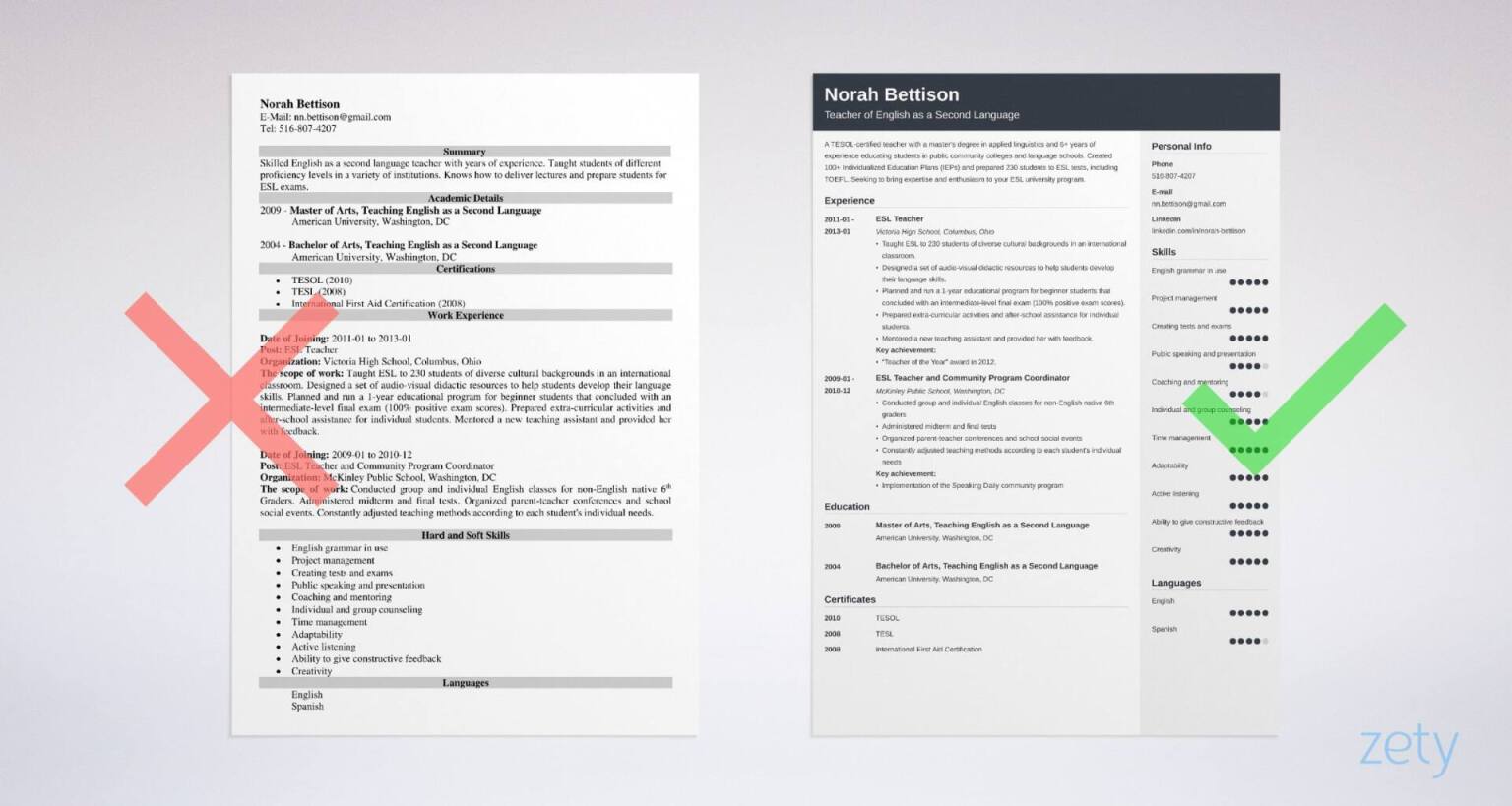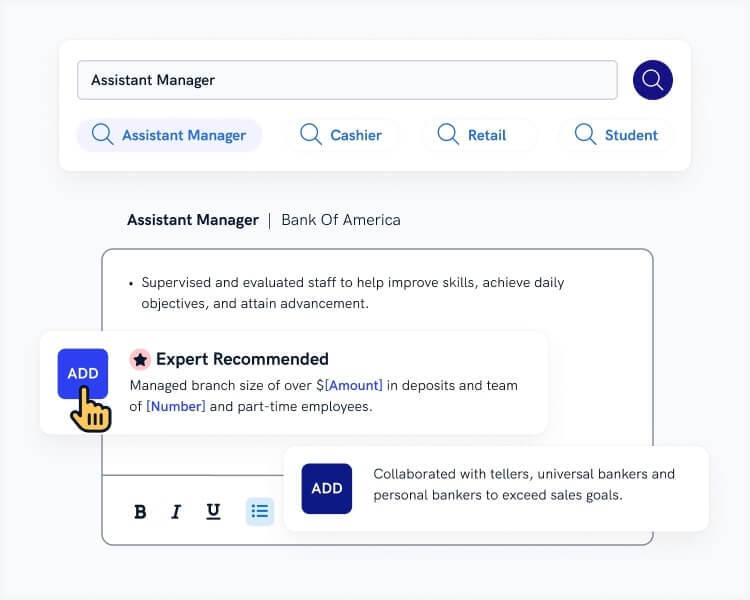ESL Teacher Resume Sample (+ ESL Teacher Skills)
Create Your Resume NowYou're searching for the perfect ESL teaching position, but first, let's talk about your resume. Just like a well-taught grammar lesson, your ESL teacher resume should be top-notch to stand out in the competitive crowd. After all, high demand equals competition.
Don't worry. We've got you covered with all you need to know to transform your resume into a linguistic masterpiece that will make hiring managers say "Bravo!"
This guide will show you:
- ESL teacher resume examples better than 9 out of 10 other resumes.
- How to write an ESL teacher resume that will land you more interviews.
- Tips and examples of how to put skills and achievements on an ESL teacher resume.
- How to write the best ESL teacher objective for a resume to get any job you want.
Want to save time and have your resume ready in 5 minutes? Try our resume builder. It’s fast and easy to use. Plus, you’ll get ready-made content to add with one click. See 20+ resume templates and create your resume here.
Sample resume made with our builder—See more resume examples here.
Need advice on how to describe your experience in other teaching jobs? Check out our guides:
- English Teacher Resume
- Education Resume Templates
- Elementary Teacher Resume
- Teacher Resume
- Tutor Resume
- New Teacher Resume
- Student Teacher Resume
- Interpreter Resume
- Translator Resume
- Best Resume Examples for All Professions
ESL Teacher Resume Example
Oliver Nelson
ESL Teacher
123-456-7890
olivernelson@email.com
linkedin.com/in/oliver.nelson
Summary
Enthusiastic and certified ESL Teacher with over 10 years of experience. Seeking to provide effective and creative instruction at LanguageLink Education by creating educational plans tailored to each student. Helped 50+ students pass IELTS tests at ESLFocus Academy, achieving a 35% increase in average scores.
Experience
ESL Teacher
ESLFocus Academy, Allentown, PA
January 2016–March 2023
Key Qualifications & Responsibilities
- Designed and implemented lesson plans focusing on English language fluency.
- Conducted engaging English learning activities to strengthen students' verbal and written skills.
- Assisted students in preparing for IELTS exams.
- Prepared and conducted cultural classes in museums.
Key Achievement:
- Improved overall student IELTS scores by 35%.
ESL Teacher
FluentCraft Language School, Allentown, PA
June 2011–December 2015
Key Qualifications & Responsibilities
- Facilitated participation in group tasks to improve students' English speaking skills.
- Tracked student progress and personalized instruction based on individual needs.
- Prepared and conducted 5 weekly classes.
Key Achievement:
- Developed creative learning resources, which resulted in a 45% improvement in student engagement.
Education
Bachelor's Degree in English Education
Pennsylvania State University, PA
September 2007–May 2011
Relevant extracurricular activities
- Volunteered to tutor ESL students, improving their language skills and confidence.
Academic achievements
- Graduated with honors (GPA 3.9).
Skills
- Lesson plan creation
- Classroom management
- Communication
- Patience
- Creativity
- Organization
- Cultural sensitivity
- Adaptability
Certifications
- TESOL Certified, TESOL International Association, 2011
Awards
- 2020, Excellence in Teaching Award, ESLFocus Academy
Memberships
Member of the TESOL International Association since 2011
Languages
- English—Native
- Spanish—Advanced
Interests
- Hosting a language learning podcast with over 5k listeners.
- Writing a blog about innovative teaching methods in language education.
Here's how to write an ESL teacher resume:
1. Format Your ESL Teacher Resume Correctly
Professor Keating, Charles Xavier, or maybe Dolores Umbridge? Regardless of the teaching style and field of expertise, there’s one thing all ESL teaching resumes should have in common.
The structure.
The best choice in almost all situations is the respected reverse-chronological resume format. It puts your most recent professional experience up front. And your future employers are most familiar with this resume layout.
Get your message across with the best resume fonts, big headings, and neat spacing.
Pro Tip: Save your ESL teacher resume as a PDF. This format keeps the layout in order. Plus, it’s machine readable.
Not sure what resume format will work best for you? Here’s the guide that will help you: Best Resume Format: Which to Choose?
2. Write an ESL Teacher Resume Objective or Summary
Recruiters are a bit like that hyper kid in the back of the classroom—
Fail to draw them in and they'll be playing Candy Crush Saga in no time.
And you have only 6 seconds to grab their attention. Otherwise, your resume will go in the bin.
There are two ways to make the recruiter read on: a resume summary or a resume objective.
When to use them?
If you have years of ESL teaching experience, use a resume summary. It will put your top skills, relevant duties, and a quantifiable achievement up front to show them you’ll be the English language instructor they need.
If you’re only starting out as an ESL teacher or have little relevant experience, write a resume objective. It will promote your skills and state your career goals to the employer. Here you can also add a key number or two to demonstrate your worth.
Look at the examples below:
ESL Teacher Resume Summary
| right |
|---|
A TESOL-certified teacher with a master's degree in applied linguistics and 6+ years of experience educating students in public community colleges and language schools. Created 100+ Individualized Education Plans (IEPs) and prepared 230 students to ESL tests, including TOEFL. Seeking to bring expertise and enthusiasm to your ESL university program. |
| wrong |
|---|
Skilled English as a second language teacher with years of experience. Taught students of different proficiency levels in a variety of institutions. Knows how to deliver lectures and prepare students for ESL exams. |
The second one is obviously a fail. Their ESL resume summary reads like something straight off a cheatsheet they found online.
The right one—
The hiring manager will jump on their desk and go O Captain! My Captain! The candidate describes their educational background, numbers, provable experience. Sure hire!
But what if you don’t yet have that much ESL teaching experience?
Look at this:
ESL Teacher Resume Objective
| right |
|---|
Bachelor graduate of linguistics from the University of Delaware and passionate ESL teacher with volunteer experience in an ESL community program at Alberts High School, New York. Knowledgeable in teaching ESL methods and classroom activating techniques. When at the university, led a peer tutoring group for 36 international ESL students. |
| wrong |
|---|
Beginner teacher of English as a second language. Open and communicative, great with children, and full of ideas for the classroom. |
The wrong examples is just anyone. You don’t want this.
Remember? When you lack professional experience for your resume, showcase your burning passion for the ESL teaching profession in your resume objective.
That’s what the good example does.
And when you add some relevant industry jargon and tasty volunteer job details, you’ll pass the test!
Still wondering how to create a powerful ESL teacher resume objective or summary? See our guides for more expert tips and examples:
- Career Objective for Your Resume: 20+ Examples for Every Profession
- Professional Resume Summary: 30 Examples and How-To Guide
3. Show ESL Teaching Experience on Your Resume
Whether you want to be hired as a public school ESL teacher or run a Business English course—the work experience section on your ESL teaching resume is the single most important section.
Why? It works a bit like a college transcript—it tells recruiters what you’ve accomplished and how good you are.
So, be exact: highlight your achievements and specify the teaching environments you worked in.
You may also bold the names of your previous employers. Especially if these are big language school brands or renowned academic institutions.
Check out these two job descriptions from ESL teacher resumes:
ESL Teacher Job Description for Resume
| right |
|---|
ESL Teacher 2011–2013
Key achievement:
|
| wrong |
|---|
ESL Teacher
|
The right example? It is an ESL teacher job description for a resume you should look up to: it has some nice resume power verbs, eye-catching numbers and percentages, and a key achievement.
The wrong example? It vaguely says something about the candidate.
And what if you’re an ESL teacher with no experience?
Focus and think about it:
Maybe you volunteered, took part in an internship, or tutored?
Even a fresh grad has some experience. So—Don’t omit the work experience section from your entry-level ESL teacher resume.
Pick activities, duties and achievements from your college or personal life that are relevant to being a great teacher of English as a second language.
Everything counts.
Pro Tip: There are many ways to gain your first ESL teaching experience. One of the most exciting ways for students and fresh grads is to join a Teaching English Abroad Program.
If you’re still not sure how to craft an ESL teacher resume work experience section, follow the tips you can find here: How to Put Work Experience on a Resume: Job Description Bullet Points Samples
Making a resume with our builder is incredibly simple. Follow our step-by-step guide, use ready-made content tailored to your job and have a resume ready in minutes.
When you’re done, our online resume builder will score your resume and our ATS resume checker will tell you exactly how to make it better.
4. Mention Your Education
What qualifications do you need to teach English as a second language?
Well, the requirements vary but they’re huge: Most public schools in the US ask for a bachelor’s degree in ESL teaching. Sometimes a master’s degree is also required.
In addition, a lot of potential ESL teaching candidates apply for a state teacher certification to get licensed.
A TESL exam is also popular as it prepares candidates to teach speakers of foreign languages in native-English countries.
Private language schools around the world may require: TESOL, TEFL or CELTA.
All in all, when you’re an educator—your education matters a lot.
Teachers in business for a long time should put the education section under the work experience section.
No work experience? Move the education section of your ESL teaching resume above the experience section. What you’ve learned and where is your biggest asset.
In any of these scenarios, list your highest degree first and follow this pattern:
- Degree
- School name and location
- Year of graduation
See the examples below:
ESL Education on a Resume
Master of Arts, Teaching English as a Second Language
American University, Washington, DC
2009
Bachelor of Arts, ELL Education
University of North Dakota, Grand Forks, ND
2004
Don’t forget about any scholarships, awards, art courses, and classroom training—
These are all extra points on the test!
Pro Tip: You may want to consider creating a separate section for your certifications. This section will do the work, especially in the ESL teacher resumes for entry-level positions.
Still not sure what to put in the education section of your resume? We’ve got you covered: How to Write the Education Resume Section [Tips & Examples]
5. Put ESL Teacher Skills on a Resume
You’re an ESL teacher ready to spread the word:
The will—checked!
The skill? One does not simply know how to explain conditionals in reported speech without a skill. (So—checked.)
Your task now is to describe this on your resume in the form of a nice list of ESL teaching skills.
But don’t just throw there all skills you can think of. Instead—Look at the job offer closely, jot down skills they’re looking for, and include them in your ESL teacher resume.
This way you’ll tailor it to the job opening and make your application stand out. Plus, since many companies nowadays rely on ATS, a screening software that scans resumes for keywords, listing relevant skills targeting a job description on your resume is how to ace it.
While doing this, focus on different types of skills:
Think of the soft skills you use in the classroom and you'll notice they closely relate to communication skills.
An involving class with no digital resources? That’s a big no-no! Plus, a great part of an ESL teaching business today happens online. So—Hard skills like computer skills and technical abilities are also a must on your ESL teacher resume!
Trying to balance it all? Look at these ESL teacher resume skills lists:
ESL Teacher Resume Skills
- Impeccable command of English grammar in use
- Good understanding of non-verbal communication and body language
- Empathy
- Sensitivity towards cultural differences
- Ability to give constructive feedback
- Ability to accept feedback
- Creativity
- Coaching and mentoring
- Multitasking
- Adaptability
- Active listening
- Open-mindedness
- Individual and group counseling
- Managing student behavior
- Teamwork skills
- Positive attitude
- Patience
- Time management
- Relationship building
- Planning
- Record keeping
- Project management
- Public speaking and presentation
- Video editing
- Classroom management
- Creating tests and exams
- Development of curriculum
- Writing lessons plans
- State educational standards
Yes, you’re right:
Some of the most important skills are already on your ESL teacher resume—in the job descriptions that you added in the work experience section:
| right |
|---|
ESL Teacher 2011–2013
Key achievement:
|
We’ve analyzed over 11 million resumes created using our builder, and we’ve discovered that:
- ESL Teachers usually list 16 skills on their resumes.
- The most common skills for ESL Teachers include empathy and patience, ESL teaching methods, adaptability and flexibility, time management abilities, and building rapport.
- Resumes for ESL Teachers are, on average, 2.6 pages long.
6. Write an ESL Teacher Resume Cover Letter
Do you really need a cover letter for your resume?
Yes!
It turns out that more than 50% hiring managers still read them.
Here’s how to write a job-winning ESL teacher cover letter:
First, research the company or school you’re applying to.
Find the exact company credentials or the full name of the school principal. Use their name and make your cover letter personal.
Next, look into the ESL teacher job description again and try to recognize the most pressing needs of the hiring institution.
Before the bell rings, you will able to highlight all the relevant skills, experiences and achievements you have to meet the company’s demands.
Write them down in three paragraphs, end with an enticing call to action, and add a postscript below your signature.
Seriously, it’s worth it!
Learn how to craft a great cover letter for an ESL teaching job here: How to Write a Cover Letter (Complete Guide with Expert Tips & Examples)
Plus, a great cover letter that matches your resume will give you an advantage over other candidates. You can write it in our cover letter builder here. Here's what it may look like:
See more cover letter templates and start writing.
Key Takeaway
Here’s a quick list of tips on how to write your ESL teacher resume:
- Choose a recommended resume template.
- Start your resume with a catchy resume summary or objective.
- Describe your duties and key achievements in bullet points (and include numbers!).
- Tailor your resume to the job description and try to recognize your future employer’s needs.
- Write a professional ESL teacher cover letter to boost your chances of landing a job interview.
Now—
Get your phone ready, you’re about to get hired!
Do you have questions on how to write a great resume for an ESL teacher? Not sure how to talk about your ESL teaching skills or achievements? Give us a shout in the comments!
About Zety’s Editorial Process
This article has been reviewed by our editorial team to make sure it follows Zety's editorial guidelines. We’re committed to sharing our expertise and giving you trustworthy career advice tailored to your needs. High-quality content is what brings over 40 million readers to our site every year. But we don't stop there. Our team conducts original research to understand the job market better, and we pride ourselves on being quoted by top universities and prime media outlets from around the world.



